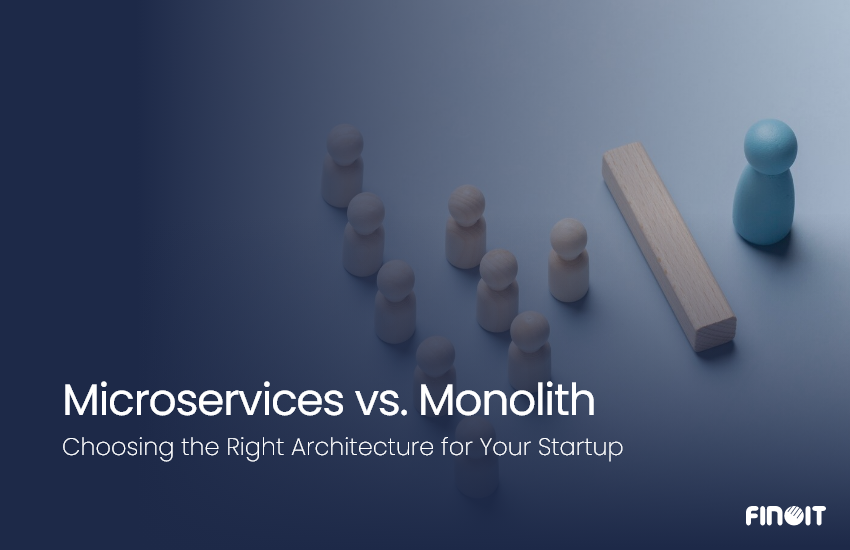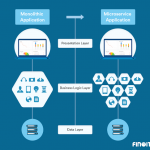Microservices vs. Monolith: Choosing the Right Architecture for Your Startup

Going for a microservices architecture seems like a no-brainer for most startups. But why do engineering teams still have to debate what architecture works best for their backend?
According to data, 84% of startups remark that investing in microservices development is the way to go. However, making that change requires a massive effort whose payoff is not always obvious.
Netflix, for instance, became a pioneer in microservices architecture after facing scalability issues with its services in 2009. Its engineering team’s effort to migrate the company’s backend from a private data center to the cloud helped it win the 2015 Ajax Special Jury Award and start a new technology era for DevOps engineers.
But not every company has to take the route Netflix took.
In this piece, we’ll look at the difference between monolith and microservices architecture, the advantages and disadvantages of each, when should your engineering team consider a monolith or microservices architecture, and how you can make the migration from a monolith to a microservices architecture effectively.
Let’s dive in.
What is Microservices Architecture?
A microservices architecture is a mix of small and autonomous self-contained services implemented as a single business ability or feature. It offers a distinct approach to developing software systems, focusing on several single-function modules with clearly defined interfaces and operations.
Microservices have become popular recently as more enterprises embrace DevOps and Agile software development methodologies.
The services in a microservices architecture are small, independent, and loosely coupled, each encapsulating a customer or business scenario. Therefore, every service typically represents a different codebase, each capable of being independently deployed.
However, since most business and customer scenarios are interconnected, the services must interact via APIs to perform complete business or customer functions.
What is a Monolithic Architecture?
A monolithic architecture is a single codebase consisting of several modules that run the application’s technical or business features. A monolithic architecture has a single build system that helps build the complete application. It also comes with a single executable or deployable binary.
A monolith architecture easily supports simple applications within minimal scalability needs and complexity, therefore making it more suited for small engineering teams and businesses.
The Benefits of Microservices Architecture
There are various compelling reasons why startups opt for a microservices architecture. They include the following:
Better Flexibility
In a microservices architecture, each service is developed independently. This allows developers to use different frameworks and programming languages that best suit the service or feature they’re developing. Therefore, the engineering team works with greater agility and flexibility.
Better Scalability
Applications using microservices architecture are easier to scale. Each service can be scaled independently based on demand without affecting other parts of the application. Therefore, you suffer fewer downtimes and enjoy improved application performance.
Better Agility
Microservices architecture makes it easier for businesses and their engineering teams to introduce new features and services without breaking the existing application. Therefore, you get faster time to market and increased competitiveness.
Better Resilience
By breaking down features and functions into independent services, microservices architecture improves the resilience of your application against errors and failures. If one service is interrupted, the rest of the application can still be accessed since other services are unaffected.
Better Support for Agile Development
Most modern engineering teams work using the agile development methodology. It allows for more flexible application development that follows evolving business and user needs.
Microservices architecture better supports agile development since engineering teams can work on a new service independently and have a single team focus on a single service, which they can iteratively develop as requirements change.
Moreover, microservices architecture allows each service to be deployed individually. This makes it easier for your engineering team to implement effective continuous integration and continuous deployment (CI/CD) workflows to support the complex features of your application.
Easier Developer Onboarding
Microservices architecture breaks down complex pieces of your application into independent services that are easier to understand and manage. Therefore, new developers joining your engineering team can understand the application and its architecture more quickly, improving the onboarding process.
Moreover, new developers don’t have to understand the whole system before beginning work. They only need to master the microservice they’re working on to get started.
Better Services
Applications running a microservices architecture are less prone to downtimes. Therefore, your users remain satisfied with the application, improving retention and loyalty for your brand. Effectively, this can improve the revenue your application generates for the business.
The Disadvantages of Microservices Architecture
Microservices architecture is not the silver bullet for agile, flexible, scalable, and reliable backed services. There are several disadvantages to opting for this kind of backend architecture.
Complex Database Transactions
Microservices architecture typically works with a partitioned database. Therefore, if a request updates multiple services inside the application, these microservices must update their databases and ensure their information is synced.
Added Project Complexity
It’s not just the database that’s a distributed system in a microservices architecture. Microservices applications are typically distributed systems, more complex than monolithic systems.
Often, developers have to implement inter-process communication based on RPC or messaging to allow the various services to coordinate and work uniformly as a single application.
Complex Application Deployment
Since microservices in a microservices architecture can be deployed individually, the deployment process has to be complex to ensure the correct runtime instances are being updated.
In contrast, monolithic applications are easier to deploy since they work on identical servers operating behind a load balancer.
It’s Difficult to Implement Changes Spanning Across Multiple Services
Microservices architecture supports easy implementation of changes affecting a single service since each is developed and deployed individually and independently. However, the process can become more complex if the changes have to span across multiple services.
Typically, each service must be deployed and integrated correctly to ensure the application is not interrupted by multiple changes across its runtime instances. With a monolithic architecture, multiple changes still get deployed in one go since the modules come bundled in one binary for the application.
More Security Vulnerabilities
While microservices architecture can potentially improve your application’s security, poor implementation can expose more security loopholes that hackers can exploit. Most vulnerabilities are exposed during inter-process communication, which hackers can use to infiltrate a service or cause downtime.
Higher Operational Costs
Monolithic architecture can work with a single compute unit. However, microservices architecture only operates through multiple units, increasing the operational costs and management of your application’s services.
More Cross-Cutting Concerns
Cross-cutting concerns, including metrics, logging, externalized configuration, and service registration, are easier to manage in a monolithic architecture since you typically work with one application instance.
However, a microservices architecture typically demands you handle cross-cutting concerns across each service, which can be more complex.
Complex Testing
Since microservice architecture works with several independent components, testing and debugging locally can be challenging.
The Advantages of a Monolith Architecture
Monolithic architecture is still viable for startups building robust applications for various reasons.
Better Performance for Small-Scale Applications
Small-scale applications often don’t get the maximum performance advantage of working with a microservices architecture. Microservices architecture relies on inter-process communication using APIs, which introduces a performance overhead compared to monolithic architectures.
For a small-scale application, the performance overhead often doesn’t justify the complexity of implementing microservices at that scale, making a monolithic architecture more viable.
Easy Control and Handling
Since monolithic apps work from a single instance, they’re easier to control and handle than microservices, where you have to fiddle with each service individually to correct and manage issues across the system.
Easy Development and Implementation
Monolithic apps are less complex to build. Therefore, your engineering team takes less development time and deploys them faster.
Easy Testing
Monolithic applications work on a single unit, simplifying testing and error detection. You can create simple automated testing and debugging scripts that will work with the runtime environment, unlike microservices, which need a more complex setup suited for the different runtime environments for each microservice.
No Silos
Monolithic architectures work without silos. This means it’s easier for developers to work on various application parts since they’re all similarly structured using the same tools.
Moreover, a well-documented and organized monolithic architecture often has few deployment and development dependencies.
The Disadvantages of a Monolithic Architecture
The monolithic architecture can favor several development teams due to its compelling advantages over microservices. However, it has several significant disadvantages.
Difficult to Adopt New Technology
Monolithic architecture is not flexible. Depending on the environment or technology stack used, monolithic applications may have to be completely rewritten to support new features and technology. This can be time-consuming and costly.
Difficult to Distribute Team Efforts
The monolithic architecture supports an application being written as one single unit. Therefore, distributing the engineering team’s efforts and assigning responsibility is difficult. This can potentially make your engineering team less effective and slower to bring new features and developments.
Poor Scalability
Once the application starts growing, scaling monolith architecture becomes very difficult. While your engineering team can create new monolith instances with a load balancer to distribute the traffic, the architecture will still not scale well as the load increases.
This is often regarded as one of its most significant weaknesses.
How Your Startup Engineering Team Can Make the Right Choice
Choosing between a microservices architecture and a monolith is crucial to ensuring your app goes live on time, your services are reliable, and you’re spending resources on the right efforts.
Here’s a breakdown of the scenarios where you need a monolith or microservices architecture to help you make the right choice.
Scenarios Where You Need a Monolith Architecture
Monolithic applications are simple and easy to implement. Therefore, the monolith architecture can be ideal for the following scenarios.
- Tight development deadlines – Since they’re simpler to develop, monolithic applications are best suited for tight development deadlines where you must show a concept working or get an early product to market.
- Small projects – Building microservices applications requires a good understanding of complex models. Therefore, you might be better off building a monolithic application for small projects and rapid prototyping.
- You have a small team at a founding stage – Microservices architecture best suits medium to large development and engineering teams with experienced members. Building a monolithic application might be the better option for a small team, especially at the founding stage.
Scenarios Where You Need a Microservices Architecture
Microservices architecture is more flexible and scalable. Here are the specific scenarios you might want to implement.
- You have a medium to large team with expert developers – Implementing microservices architecture is more effective when working with expert developers. Moreover, you see more benefits if you use the agile development methodology.
- You plan to upgrade and add new features to the application in the future – Microservices architecture is best suited for applications that need to scale quickly and adopt new features and technologies in the future. Therefore, you’re more open to advanced solutions, making you highly competitive.
How You Can Migrate from a Monolith to a Microservices Architecture
For most engineering teams, transitioning from the monolith to microservices architecture is inevitable as the application grows and user and business requirements increase. While the change should help improve the application’s development, deployment, and reliability, not doing the transition well might cause a lot of trouble.
Here are a few tips on how you can make the transition right.
Create a Migration Strategy
Your engineering team should determine the sequence of migrating customers to the new architecture. You should prioritize uptimes for critical services and thorough testing before deployment to ensure minimal service interruption.
Gather the Right Tools
Before migrating, ensure you’ve gathered the right tools for the job and informed customers of the upcoming changes. Some of these tools include a service catalog for tracking all microservices and automated code checkers to ensure new code for the services is free of quality, security, and design issues.
Manage Expectations
Making the migration from a monolith architecture to microservices will come with several inevitable interruptions and cultural changes. You’ll have to introduce new systems, tools, and processes to make the move effective and permanent.
Therefore, customer’s and the engineering team’s expectations must be managed, with everyone aware that the benefits of the migration will show in the long run and not immediately.
Have an Expert Help You Choose the Right Architecture
Starting to build your startup’s applications and tech systems can be an exciting and confusing phase. Depending on your needs, a monolith or microservices infrastructure might be the best way to start and build a robust and reliable application for your clients and business.
Contact an expert and let them guide you on which architecture will work best.

